

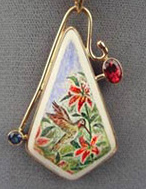
Ivory, as defined by most gemologists, is derived from the teeth or tusks of mammals, although some other materials with similar characteristics and appearance have traditionally been given this name. Examples of tooth ivory are less common, and generally limited to: hippo and sperm whale teeth (teeth are defined as dentition which is not visible when the mouth is closed, whereas a tusk protrudes from the closed mouth). Tusks from African and Asian elephants, wild boars, walruses and narwhals as well as extinct mammoths and mastodons have been used throughout history (and pre-history) to produce a range of ornamental and useful objects. Simple ivory amulets and tools have been found in archeological sites dating 7000 years before present. The Chinese penchant for ivory goes far back in their history (5000 BCE) as does their supremacy in the art of carving it into intricate designs and inlays. By 500 BCE India was engaged in a vigorous ivory export trade.
The properties of ivory vary somewhat by species in terms of hardness, uniformity and the basic shape of the raw material. Some sources, like elephant tusk, provide large, mostly solid pieces, whereas other types (like narwhal tusks) are mostly hollow, and others like hippo teeth are smaller, which can limit useage to certain sizes or shapes. The hardest and whitest ivory is derived from hippo teeth which makes them more difficult to carve, but less likely to stain and crack.
The majority of very old ivory carvings and ornaments are probably from Asian elephants whose tusks are relatively smaller and found only on male animals. Within the last several hundred years, however, the African elephant has been the ivory provider of choice, due to its historically greater population numbers, larger tusks, and the fact that both sexes are tusked.
The once thriving commerce in African elephant ivory would stagger today's conservation minded individual -- before plastics were invented in the late 19th century, ivory was the source for such diverse and universal items as buttons, hair combs, jewelry, furniture inlay, billiard balls and veneer for piano keys. (The finest billiard ball makers produced only three balls per tusk).
By the 1970's when the environmental movement swept the Western world, the consequences of this carnage were obvious. In 1989 a world-wide ban on elephant ivory trade was instituted as part of CITES (Convention on the International Trade in Endangered Species). This treaty has had mixed, mostly positive, results, with elephant populations rebounding to a degree, and interest in still-legal forms of ivory and ivory simulants increasing. The down-side is the inevitable escalation of value of elephant ivory objects, and consequent stimulation of black market trade. Currently small parcels of CITES approved ivory from elephants dying of natural causes or captured goods from smugglers are legally sold to finance conservation efforts.



Until about 7-10,000 years ago, mammoths ranged over Eurasia and mastodons over the Americas. Throughout their long reign as species, innumerable individuals died and were buried in mud, ice or peat. These artifacts, although not mineralized in the true sense of fossilization, have been preserved, and due to erosion, geological events or mining have been, and are being, unearthed and used as ivory sources.
Like all elephant ivories these show distinct structural properties which result in a layered structure in longitudinal section and a cross hatched pattern in cross section. This characteristic called the "engine turned" effect is diagnostic of elephantine ivories and absent in all other forms. These ancient ivories sometimes have acquired unusual colors through long contact with minerals and mineral solutions.
Such materials are not covered by CITES, indeed the species are already extinct, and are becoming very popular. In the US, digging for anything on public lands is restricted by Federal land management agencies, but in Alaska, Canada, Greenland and Siberia, Inuits and other native peoples have been greatly benefited by the ability to harvest, fashion, and trade these items to an eager world market.

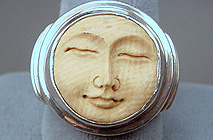
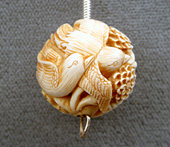
Marine mammals, particularly walruses, and toothed whales (sperm whales and orcas) have been a long treasured source of ivory for populations in locations where these species are common. Inuits, in fact have a much longer history of walrus ivory use than that of the much harder to kill whales. Marine mammals are protected from harvest, except for quotas for certain native peoples who have the right to use their legal catches for meat, hide, bone and ivory and the right to fashion and sell such artifacts. This represents a welcome economic benefit for such groups, as well as a valuable stimulus to preservation of ancestral arts and crafts.
Walruses being at least semi-terrestrial animals have also been long buried and recently unearthed -- such "fossil" walrus ivory can also be legally collected and traded by indigenous peoples. In structure walrus ivory shows a distinct core region when sliced in cross section.

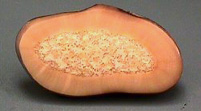
Sperm whale teeth have a long history of use in New England in the USA, and throughout the whaling nations of the world. The most common way the teeth were fashioned was by leaving them whole or taking small sections and decorating the piece with an engraved and colored design, called scrimshaw. Most often the designs were related to nautical or whaling subjects.

At present hippos are not considered endangered and are not covered by CITES. They shed teeth naturally which people located in their habitats can collect and legally sell to much of the world (the US, UK and most European countries, however, do not allow any "raw" ivory to be imported, regardless of source). There is a huge market in Japan and China, though, where small carved objects of hippo ivory have largely replaced those of elephant ivory.
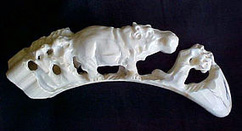
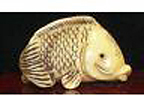
During the Victorian Era many gems of organic origin were in favor, including obscure ivories such as seen in this circa 1870 brooch fashioned of two animal (pig?) teeth.

Although most would define ivory as deriving from mammal teeth, one notable exception is the case of hornbill "ivory". Technically the material is more akin to horn than tooth as it derives from the "casque" or second beak which grows on top of the regular beak in this group of souteastern Asian birds. It is a golden color and exceptionally translucent with the most coveted and expensive specimens showing a bright red "rim". These birds are endangered and cannot be legally hunted, nor can items from them be traded except under restricted conditions as certifed antiques in some parts of the world.
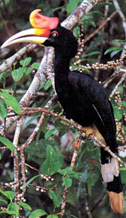
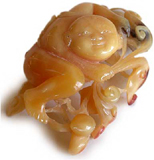
With the current restrictions on ivory trade in place, we can easily understand the emphasis on simulants in today's market, but simulation of ivory is nothing new. Ivory has always been an expensive, limited, and much imitated material. Two natural materials which have a long histories of use as substitutes, are bone and "vegetable ivory" derived from tagua (S. America) or doum palm (Africa) nuts. Early plastics such as celluloid and casein were widely popular as faux ivory from the late 19th century, with modern plastics carrying on the tradition today.
Simulants can be detected relatively easily by microscopic examination. Plastics and vegetable ivory show a complete lack of the "structure" typical of ivories. Bone, although showing internal patterns that verify its origin as an animal tissue, is quite distinctive with its Haversian Canals.

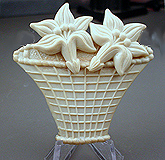
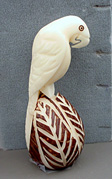
Relatively little in the way of enhancement is used on ivory, the most common being the staining of newly carved items with tobacco juice, tea or other dyes to simulate the appearance of great age. Similar effects can be obtained with gentle heat or irradiation. Mild bleaching solutions of hydrogen peroxide or chlorine can even out color, and remove some blemishes, and is occasionally done. Very rarely specimens of bone or ivory are dyed blue with copper salts to simulate a rare, naturally colored, fossil ivory known as odontolite.
As a soft organic gem, ivory deserves gentle cleaning and careful use. Wiping the piece with a damp cloth should suffice for most cleaning needs and prolonged exposure to high temperatures should be avoided.
Because important legal and ethical factors restrict and influence the market for ivory, it is difficult to generalize about value. Clearly, antique ivory objects, under conditions where they can be legally traded, are valued based on the rarity of the materials, their age, provenance, and the artistry of their fashioning. Examples of items for which collectors (ethical and otherwise) will pay dearly are large elephant ivory pieces, narwhal tusk work, and most precious of all, hornbill "ivory" carvings.
In the arena of legally traded ivories and ivory simulants, most items are modestly priced with rarer and larger items and those with greater antiquity or higher artistic merit at the top, and vegetable ivory, bone, and plastic simulants in the lower brackets. "Fossil" ivories which have been stained attractive colors through natural mineral processes do bring a premium price. In any ivory piece, translucence and freedom from cracks is valued. Yellowish, orangey and brownish hues (unless they are deliberately applied to simulate age) add value as a patina.